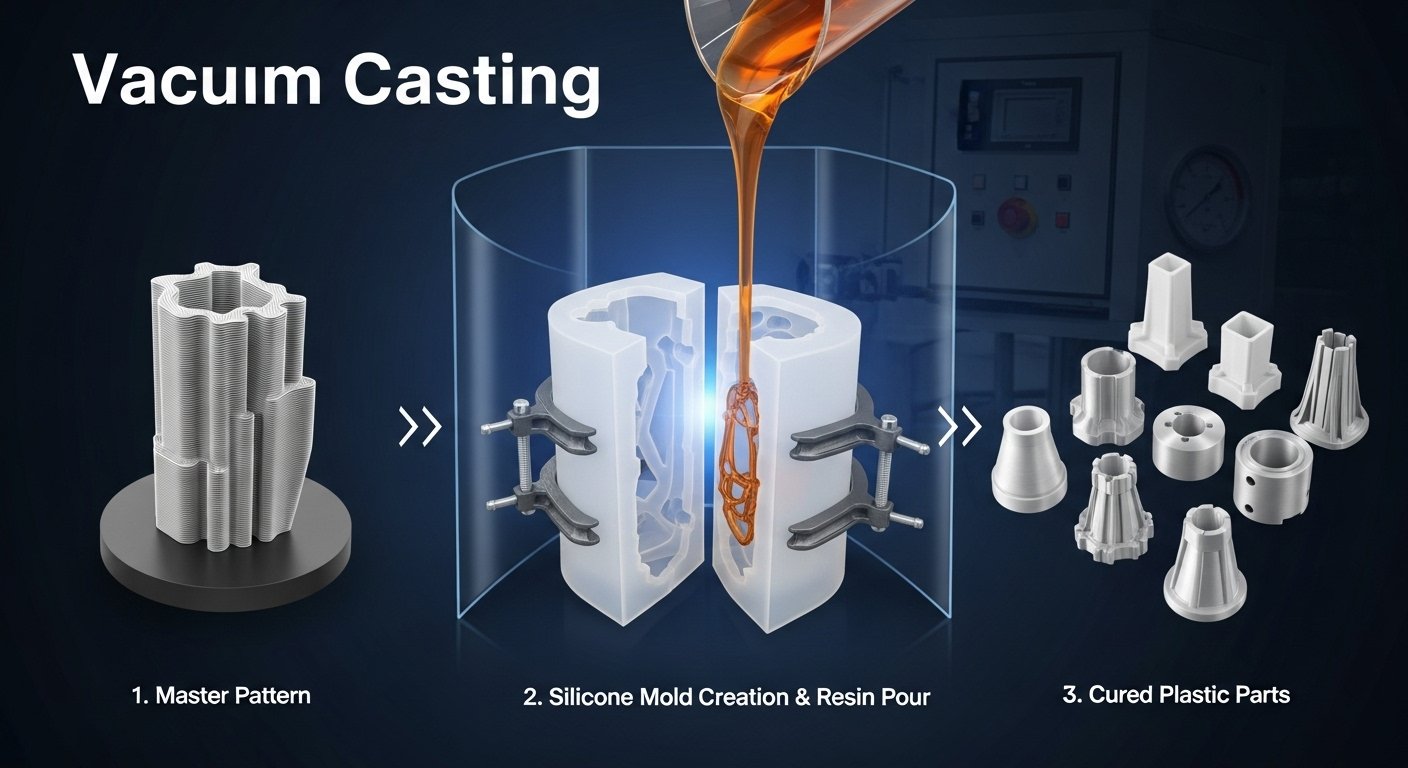Are you looking for a reliable way to create high-quality prototypes without breaking the bank? Vacuum casting services might be the perfect solution. This versatile manufacturing technique bridges the gap between one-off prototypes and full-scale production, offering exceptional detail and speed. Whether you’re in product development, automotive design, or consumer goods, understanding vacuum casting can transform your prototyping process.
In this comprehensive guide, we’ll dive into what vacuum casting services entail, how they work, their key benefits, and much more. By the end, you’ll have the insights needed to choose the right provider and leverage this technology for your projects. Let’s get started.
What Is Vacuum Casting?
Vacuum casting, also known as urethane casting or silicone molding, is a rapid prototyping method that uses a vacuum to draw liquid material into a mold. It’s ideal for producing small batches of functional parts that mimic the properties of injection-molded plastics.
Unlike traditional casting, vacuum casting eliminates air bubbles, ensuring smooth, detailed finishes. This process starts with a master pattern—often created via 3D printing or CNC machining—and involves creating a flexible silicone mold. The result? Parts that are durable, aesthetically pleasing, and ready for testing or end-use.
Why choose vacuum casting services over other methods? It’s cost-effective for runs of 10 to 50 units, making it a go-to for startups and designers iterating on ideas. For instance, imagine developing a new gadget housing—you can test multiple variations quickly without committing to expensive tooling.
How Does Vacuum Casting Work?
The vacuum casting process is straightforward yet precise, involving several key steps. Here’s a breakdown to help you visualize it.
Step 1: Creating the Master Pattern
Everything begins with a high-quality master model. This is typically produced using SLA 3D printing or CNC milling for accuracy. The master must capture every detail, as it will dictate the final part’s quality.
Providers of vacuum casting services often offer in-house pattern creation to ensure compatibility. Have you ever wondered why the master is so crucial? Any imperfections here will replicate across all casts, so precision is non-negotiable.
Step 2: Silicone Mold Making
Once the master is ready, it’s encased in liquid silicone rubber. The mixture cures around the pattern, forming a flexible mold that can be split open. This mold can withstand 20-50 casts before degrading, depending on complexity.
Vacuum casting services handle this with expertise, using high-grade silicone for durability. The mold’s flexibility allows for undercuts and intricate geometries that rigid molds can’t manage.
Step 3: Casting the Parts
In the vacuum chamber, polyurethane resin (or similar material) is mixed and poured into the mold. The vacuum removes air, preventing bubbles and ensuring even distribution.
After curing—often accelerated with heat—the parts are removed, trimmed, and finished. This step highlights why vacuum casting excels in prototype casting: it delivers parts in days, not weeks.
Benefits of Vacuum Casting Services
What makes vacuum casting services stand out in the world of rapid prototyping? Let’s explore the advantages that draw engineers and designers to this method.
1. High Precision and Fine Detail
Vacuum casting captures intricate features like textures and thin walls with remarkable accuracy—often within ±0.1mm tolerances. This level of detail is perfect for aesthetic prototypes or functional testing.
For example, in medical device development, parts must fit precisely; vacuum casting ensures they do, reducing revision cycles.
2. Cost-Effective for Low-Volume Production
Unlike injection molding, which requires costly steel tools, vacuum casting uses affordable silicone molds. This slashes upfront costs, making it ideal for low-volume manufacturing of 5-100 units.
Businesses save thousands by avoiding mass production setups until designs are validated. Isn’t it smarter to test the market with prototypes that look and feel like the real thing?
3. Fast Turnaround Times
Need parts quickly? Vacuum casting services can deliver in as little as 3-7 days. This speed supports agile development, where time-to-market is critical.
In industries like consumer electronics, rapid iterations mean staying ahead of competitors. Providers often offer instant quoting to streamline the process further.
4. Versatile Material Options
From flexible rubbers to rigid plastics, vacuum casting supports a wide range of polyurethane resins that simulate ABS, PC, or even rubber. This versatility allows for material testing without full production commitments.
Applications of Vacuum Casting
Vacuum casting services shine in diverse fields. In automotive, it’s used for dashboard prototypes or light covers. Aerospace benefits from lightweight, detailed components for testing.
Consumer products like phone cases or toys leverage its aesthetic finishes. Medical devices, electronics enclosures, and even art installations use vacuum casting for its precision and speed.
Consider a startup creating wearable tech: vacuum casting allows quick production of ergonomic prototypes for user feedback, accelerating product launches.
For more on how this fits into broader manufacturing strategies, check out our related article on rapid prototyping techniques.
Materials Used in Vacuum Casting
The heart of vacuum casting lies in its materials. Polyurethane resins are the most common, offering properties like transparency, flame retardancy, or high impact resistance.
Options include:
- ABS-like resins for toughness.
- Rubber-like materials for flexibility.
- Clear resins for optical applications.
Specialty blends can mimic nylon or polypropylene. When selecting vacuum casting services, ask about material certifications, especially for regulated industries like healthcare.
This variety ensures parts not only look right but perform as needed in real-world scenarios.
Technical Specifications and Tolerances
Understanding specs is key when evaluating vacuum casting services. Standard tolerances range from ±0.1mm to ±0.5mm, depending on part size—up to 2 meters in some cases.
Wall thickness should be at least 0.5mm to avoid defects. Maximum build sizes vary by provider, but many handle parts up to 1000x700x400mm.
Factors like shrinkage (0.15-0.3%) are accounted for in design. Always request a DFM (Design for Manufacturability) analysis to optimize your parts.
Surface Finishes and Post-Processing
Vacuum casting delivers smooth surfaces out of the mold, but post-processing elevates them. Options include:
- Painting and electroplating for metallic looks.
- Polishing for high-gloss finishes.
- Texturing or inlaying inserts.
These enhance aesthetics and functionality. For instance, a matte finish might reduce glare on display prototypes.
Top vacuum casting services offer comprehensive finishing to match production standards.
Choosing the Right Vacuum Casting Service Provider
Not all providers are equal. Look for those with ISO certifications, in-house capabilities, and positive reviews. Factors to consider:
- Lead times and quoting speed.
- Material variety and expertise.
- Quality control processes.
Providers like those specializing in prototype development often include free consultations. Suggest linking to CNC machining services for hybrid approaches.
Vacuum Casting vs. Other Prototyping Methods
How does vacuum casting stack up? Compared to 3D printing, it offers better material properties and finishes for larger batches. Injection molding is for high volumes but costlier upfront.
SLA printing is faster for singles but lacks durability. Vacuum casting strikes a balance for mid-range needs.
In short, if you’re beyond one-offs but not ready for mass production, this is your method.
Conclusion
Vacuum casting services revolutionize prototyping by combining speed, precision, and affordability. Whether you’re validating designs or producing small runs, this technique delivers results that propel projects forward.
Ready to get started? Research providers, request quotes, and watch your ideas come to life. For deeper dives, explore our guides on urethane casting alternatives or silicone molding tips.
Explore More Topic: BebasinIndo
FAQ
What is the vacuum casting process?
The vacuum casting process involves creating a master pattern, forming a silicone mold around it, and then pouring polyurethane resin under vacuum to produce detailed parts. It’s widely used in rapid prototyping for its accuracy and efficiency.
How much do vacuum casting services cost?
Costs for vacuum casting services typically range from $50 to $500 per part, depending on complexity, materials, and quantity. Molds add $200-$1000 upfront, but per-unit prices drop with volume.
What materials are commonly used in vacuum casting?
Common materials include polyurethane resins that simulate ABS, rubber, or clear plastics. These offer versatility for various applications, from flexible components to rigid prototypes.
Is vacuum casting suitable for full-scale production?
While ideal for low-volume production (up to 100 units), vacuum casting isn’t suited for mass production due to mold wear. For larger runs, transition to injection molding.



